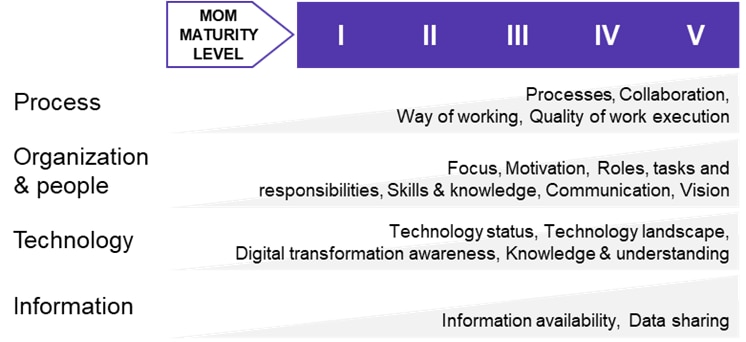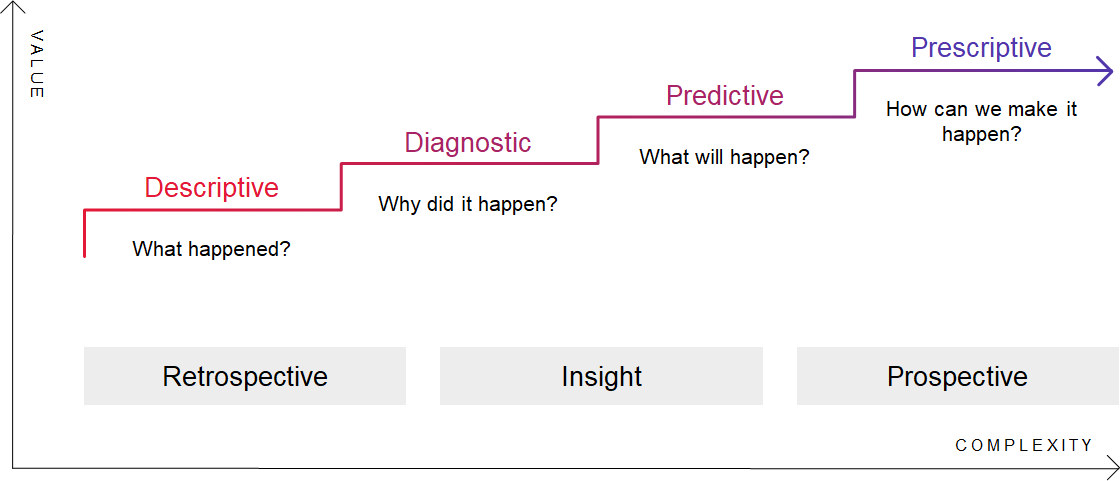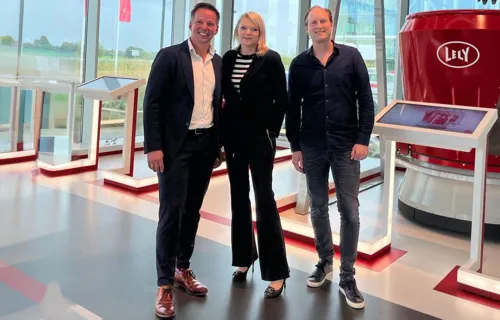Do you know which steps and in which order you need to take them to get to Prescriptive Maintenance? How to come up with a practical implementable step-by-step plan with complete digitization of your assets as the end goal, aligned with your current organization and current way of working.
More and more of our clients give top priority to the digitization of their manufacturing domain. Manufacturing companies are confronted with a continuously changing customer demand and increasing expectations in terms of product diversity, quality, safety and sustainability. These changing customer demands call for efficient, effective and adaptive manufacturing processes.
The maintenance domain plays an important role within manufacturing and prescriptive maintenance is the ultimate maturity level in response to the challenges mentioned above. But how do you ensure that your maintenance organization and way of working fully develops to the desired level, so that you really get the added value from the digital transition?
In the next 3 blogs, I am sharing my vision and expertise developed through years of working with a variety of clients. Key to this vision: Step-by-step with a focus on all POTI aspects (Process, Organization, Technology, and Information) as depicted in figure 1. These are the building blocks for each step and recurring structural elements in this blog series.

Figuur 1 POTI aspecten
What is Prescriptive maintenance?
Prescriptive maintenance is maintenance that is prescribed based on analyzed data of the state of production machine parts. Translated practically: what maintenance actions are needed and when? How should these activities be carried out, with which tools and parts, and what results can be expected from these activities? In other words: you are in full control of your production performance through real-time insight into the condition of production assets and a maintenance recommendation based on validated data.
What applies to human development, also applies to the growth in maturity when we look at maintenance: “First learn to crawl before you learn to walk". There is no point in implementing complete digitization and seeking to use the latest available technologies such as Artificial Intelligence (AI), Augmented Reality (AR), Virtual Reality (VR), when there is no ‘control’ over the execution of the current workload and when the maturity of maintenance organization is low where production machines are mostly reactively maintained.
STEP 1: How to be in control?
To be in control means being able, as a maintenance organization, to carry out the full range of work, including preventive maintenance, within the agreed time frame. This calls for a good balance between work supply and execution capacity, combined with the "steering ability" to anticipate surprises in a timely manner. CGI's experience is that attention to each of the four POTI aspects is peripheral to successfully obtaining and controlling this balance. This is why these four important POTI aspects form part of our methodology and way of working: from the first assessment to the solutions and advice we provide to our clients.
An important start in our approach is to get a good picture of the current situation. CGI's maturity assessment provides the necessary detailed insight into the current way of working of your maintenance organization and answers questions such as: what work processes are already in place, what is the availability and quality of asset data and information, is a CMMS being used, what roles have been arranged within the maintenance organization and what is the training requirement of employees? The answers to these questions enable us to use our maturity model (see figure 2) to precisely tailor the optimization advice to your current situation.

Figuur 2 Maturity model
ORGANISATION
Often, the first step of implementing optimization advice is related to the core rolls within a maintenance organization. In order to achieve control over the execution of current workloads, it is desirable to distinguish between short-term activities ( day-to-day / <week) and medium-term activities (>week) in the preparation and coordination of work, and assigning these activities to different role-players. Important core roles of a maintenance organization in this first step in maturity growth are: team leader, planner & work engineer, reliability engineer and, of course, the role of technician. What does this distinction mean in practice?
- The team leader focuses on the short term and co-ordinates work in progress / under way;
- The planner & work engineer focuses on full preparation of work to be performed and, due to the separation of roles with the team leader, is given the necessary peace and space to do so;
- The reliability engineer focuses in this first phase of maturity growth on preventing repetitive technical failures and ensures a thorough preventive maintenance plan.
PROCESS
The next step in implementing optimization advice is establishing and putting in place a standardized work order fulfilment process. This work process ensures a unified view within production of how work requests to the maintenance organization are handled. An important point to consider when embedding the work process is that tasks, responsibilities and authority (TVB) of this process align with the core roles within the maintenance organization.
TECHNOLOGY & INFORMATION
It is of great value for a successful implementation of the previously described work process that the CMMS functionalities made available to each core role are aligned with the tasks, responsibilities and authority associated with that role. The system functionality combined with the availability of correct information contributes enormously to the effective and efficient execution of work orders.
As I mentioned earlier, in this first maturity step, the Reliability Engineer's focus is on understanding most critical assets and preparing preventive maintenance plans. Analyzing technical malfunctions of production machines is also one of his/her main tasks. The prevention of recurring technical disruptions leads directly to higher machine availability which in turn enables production to produce more or more efficiently. The cost savings realized through the elimination and prevention of malfunctions and the increase in revenue due to higher machine availability can, in most cases, cover the investment for the optimization program (Business Case).
Conclusion
Make sure to get in control first of all. This is where an assessment can bring necessary insights for each of the POTI aspects: Process, Organization, Technology and Information. This assessment gives you a clear (re)starting point for further optimization to a level where you have gained control over the maintenance processes. Otherwise, the outcome of the transition will always be sub-optimal when ignoring any of these aspects.
CGI has the approach and experienced consultants to work with you to take the first step toward prescriptive maintenance. Are you up for the challenge?
In my next blog, I'd like to share my views and insights on how to move on from the maturity phase 'in-control' to 'predictive maintenance'. Can't wait or have other ideas please contact me for further conversation.





